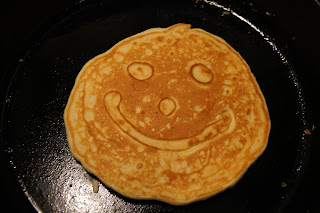My kids are going to know about fractions and basic fraction addition before they get to kindergarten. Seriously. And it isn't because they're little prodigies, either.
It's because we love pancakes.
About once per week, whether a dinner or weekend breakfast, Norah and I join up in the kitchen to whip up some flapjacks. She gets her special apron from the cabinet and I gather all the equipment she'll need. From her own special set I'll grab the whisk, the measuring cups and spoons. I'll take a big bowl down from the shelf, a bit bigger than really needed, but more forgiving to her developing mixing skills.
Then, one by one, I'll get the ingredients out and we'll measure out the flour, sugar, baking powder, baking soda, salt, milk, and oil (plus the egg). This is where fractions come in. Right now, Norah's getting used to the vocabulary of measurements: a half, one quarter, two thirds, etc. Eventually, we'll move on to adding fractions: if we need three quarters of a cup of milk, but all we can find is the 1/2 and the 1/4 measuring cups, how do we do that?
Fractions.
And, throughout all of this, Norah's helping daddy make something. She loves that, and so do I.
Except when she's trying to take a hammer to a $300 set of shelves I'd just finished. I have my limits.
Here's a little tip to brighten her day just a little bit. Put some pancake batter in a ziplock baggie and snip off the smallest bit of one of the corners. Then, "draw" something she'd like on her pancake, like a smiley face. Let it cook for a little bit so it's darker in the end, then pour batter over top of it. Your kid will love it.
As a bonus, if you want to score a brownie point or two you can put a heart in the pancake for your significant other.
It's because we love pancakes.
About once per week, whether a dinner or weekend breakfast, Norah and I join up in the kitchen to whip up some flapjacks. She gets her special apron from the cabinet and I gather all the equipment she'll need. From her own special set I'll grab the whisk, the measuring cups and spoons. I'll take a big bowl down from the shelf, a bit bigger than really needed, but more forgiving to her developing mixing skills.
Then, one by one, I'll get the ingredients out and we'll measure out the flour, sugar, baking powder, baking soda, salt, milk, and oil (plus the egg). This is where fractions come in. Right now, Norah's getting used to the vocabulary of measurements: a half, one quarter, two thirds, etc. Eventually, we'll move on to adding fractions: if we need three quarters of a cup of milk, but all we can find is the 1/2 and the 1/4 measuring cups, how do we do that?
Fractions.
And, throughout all of this, Norah's helping daddy make something. She loves that, and so do I.
Except when she's trying to take a hammer to a $300 set of shelves I'd just finished. I have my limits.
Here's a little tip to brighten her day just a little bit. Put some pancake batter in a ziplock baggie and snip off the smallest bit of one of the corners. Then, "draw" something she'd like on her pancake, like a smiley face. Let it cook for a little bit so it's darker in the end, then pour batter over top of it. Your kid will love it.
As a bonus, if you want to score a brownie point or two you can put a heart in the pancake for your significant other.






































